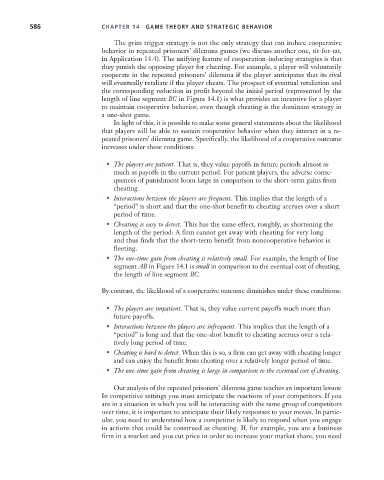Page 612 - Microeconomics, Fourth Edition
P. 612
c14gametheoryandstrategicbehavior.qxd 8/6/10 8:22 AM Page 586
586 CHAPTER 14 GAME THEORY AND STRATEGIC BEHAVIOR
The grim trigger strategy is not the only strategy that can induce cooperative
behavior in repeated prisoners’ dilemma games (we discuss another one, tit-for-tat,
in Application 14.4). The unifying feature of cooperation-inducing strategies is that
they punish the opposing player for cheating. For example, a player will voluntarily
cooperate in the repeated prisoners’ dilemma if the player anticipates that its rival
will eventually retaliate if the player cheats. The prospect of eventual retaliation and
the corresponding reduction in profit beyond the initial period (represented by the
length of line segment BC in Figure 14.1) is what provides an incentive for a player
to maintain cooperative behavior, even though cheating is the dominant strategy in
a one-shot game.
In light of this, it is possible to make some general statements about the likelihood
that players will be able to sustain cooperative behavior when they interact in a re-
peated prisoners’ dilemma game. Specifically, the likelihood of a cooperative outcome
increases under these conditions:
• The players are patient. That is, they value payoffs in future periods almost as
much as payoffs in the current period. For patient players, the adverse conse-
quences of punishment loom large in comparison to the short-term gains from
cheating.
• Interactions between the players are frequent. This implies that the length of a
“period” is short and that the one-shot benefit to cheating accrues over a short
period of time.
• Cheating is easy to detect. This has the same effect, roughly, as shortening the
length of the period: A firm cannot get away with cheating for very long
and thus finds that the short-term benefit from noncooperative behavior is
fleeting.
• The one-time gain from cheating is relatively small. For example, the length of line
segment AB in Figure 14.1 is small in comparison to the eventual cost of cheating,
the length of line segment BC.
By contrast, the likelihood of a cooperative outcome diminishes under these conditions:
• The players are impatient. That is, they value current payoffs much more than
future payoffs.
• Interactions between the players are infrequent. This implies that the length of a
“period” is long and that the one-shot benefit to cheating accrues over a rela-
tively long period of time.
• Cheating is hard to detect. When this is so, a firm can get away with cheating longer
and can enjoy the benefit from cheating over a relatively longer period of time.
• The one-time gain from cheating is large in comparison to the eventual cost of cheating.
Our analysis of the repeated prisoners’ dilemma game teaches an important lesson:
In competitive settings you must anticipate the reactions of your competitors. If you
are in a situation in which you will be interacting with the same group of competitors
over time, it is important to anticipate their likely responses to your moves. In partic-
ular, you need to understand how a competitor is likely to respond when you engage
in actions that could be construed as cheating. If, for example, you are a business
firm in a market and you cut price in order to increase your market share, you need

